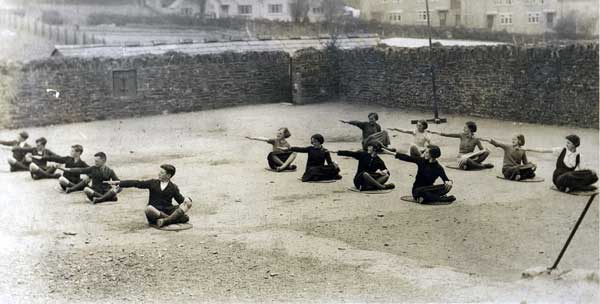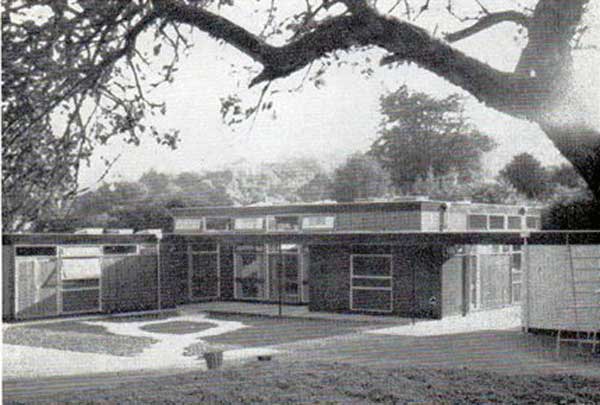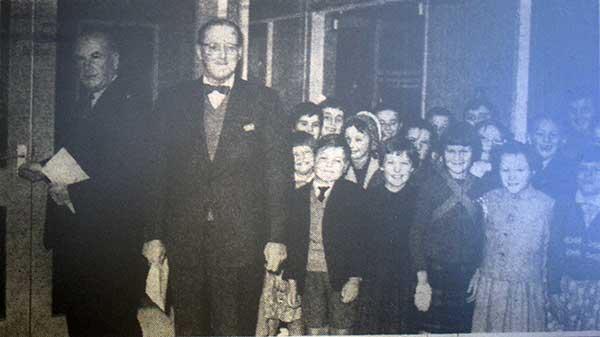.
By William Barry Vanstone (b. 1943), as part of his thesis at Westminster College, Oxford, of which this extract was published in the Cornish and Devon Post in December 1965. Barry was the eldest son of Mr and Mrs W. G. Vanstone of Lifton Park Farm. He himself went to the Lifton Schools before moving on to Okehampton Secondary Modern School, from which he was later transferred to Okehampton Grammar School. He then went to Oxford, where he qualified as a teacher in a three-year course. He then went on to become a History Master at Peterborough Secondary Modern School, also serving as a physical education instructor at the school.

The school built in 1871 was not the first to be established in Lifton. The earliest record of a school in Lifton parish is a reference in the Universal British Directory, to a Mr Jonathon Bullen, Schoolmaster, who lived in the village in 1792; while in 1822, the Magna Brittanica refers to a school for 80 children open Sundays and Wednesdays and also mentions another school, patronised by Mrs Harris, of Haine, for 25 children, who were clothed and educated at her expense.
William Vanstone states that in the Boy’s Log Book there is mention that Miss Stentaford, the first Headmistress of the Girl’s School, had already been teaching in Lifton for 19 years at a school run by Mrs Bradshaw at Underwood in Lifton Park. Thus it would be conclusive that there had been a school in Lifton since 1853. He points out, however, that there is evidence that this school was for girls only and that there does not seem to be any indication that there was a school provided for the education of the boys of the parish.
As most of the adults of the village were employed on the Lifton Park Estate, no doubt the Bradshaws saw to it that it was from them that any attempt at providing education must come. Henry Bradshaw had come from Runcorn, Cheshire, where his father carried on an extensive business. In the middle of the Nineteenth Century, Henry came to Lifton after buying Lifton Park and the estates attached to it, extending into several parishes (7,000 acres). Soon after this Henry married the eldest daughter of the vendor, a Mr Arthur Arundel, and then took up residence at Lifton Park. Mrs Bradshaw had more interest in the school than her husband, and she was probably born at Lifton Park and had a far deeper interest and understanding of local society.

OPENED IN 1873
The schools, so-called because they comprised two separate schools, one for boys and one for girls, but both in the same building, were officially opened in November 1873, (Nearly a hundred years later, older members of the community still referred to the Primary School as ‘The Schools.’). The opening ceremony was carried out in conjunction with the re-opening of the Parish Church. The schools were designed by Mr R. Bevan and built in the form of two large rooms with cloakrooms attached to each, one side for the boys and the other for the girls.
The idea of having a new school built was Mrs Bradshaw’s who, no doubt wishing to extend the school already at Underwood, persuaded her husband, Henry, to erect a new building in the village. Here, Henry Bradshaw’s generosity seems abounding, for he presented his wife with this new school as an anniversary wedding present at a cost of over £900. Henry Bradshaw further increased this gift by ordering the erection of a wing, 24 feet square, to accommodate the infant class, adding a further £100 to the bill. Quite probably, Henry Bradshaw saw that there might have been some difficulty in meeting the requirements of the 1870 Education Act, and thus took the opportunity of alleviating the problem by presenting a new school to his wife. For many years after the erection of the Schools, they were admired by all. Frequently lessons were interrupted while visitors were shown around the premises, and an Inspector wrote at Christmas, 1871: “I feel confident that the method of instruction here is worthy of the noble and educationally perfect building in which it is carried on.”
The admission register for 1871 shows that 170 children were admitted to the schools; by 1874 the number had risen to 277 children. The curriculum that the new Schools followed was quite conventional. Arithmetic, writing and reading were of primary importance and also taught were geography, singing, religious instruction, physical exercises and needlework for the girls and gardening for the boys. It appears that fourpence was the weekly fee for attending the Schools.
FIRST HEADMASTER
The first headmaster appointed to the Boys’ School was Mr Henry Buckingham, who was to become a very prominent member of the village community. He put the Schools on a firm footing, which was maintained throughout the 32 years he spent as headmaster of the Boys’ department. Miss Stentaford was the headmistress of the Girls’ department and was also in charge of the infants’ school. As previously mentioned, the school curriculum was quite conventional. The history was based on the history of England only, and religious education was concerned with the Old and New Testaments and the Catechism. This was because the schools were connected with the Church of England which was represented on the School Management Committee by the Vicar, Rev. W. W. Martyn. The curriculum varied quite considerably in the later 19th Century. In 1895, an Inspector gave permission for the girls to be taught domestic economy instead of grammar and in the same year, younger children were introduced to crayon drawing. The elder children began basket making, and the next year, musical drill was introduced in the curriculum. During the later years of the 19th Century, there was a great movement for temperance among ordinary people. There are notes in the Girls’ Log Book which show how the children were instructed in the dangers of drink. During January of 1890, the children were taught a new song called “Water is Best” and in March 1898, “Mr Joseph Gray gave the children a lecture on the most important parts of the human body, the lecturer’s idea being to convey to the children’s minds the great necessity of their being temperate in all things.”
Much of the teaching of the subjects was done by “Gallery lessons” – lessons where a great many children could be instructed at once. The children sat on long benches which were set at ever-increasing heights, much like a staircase. There seemed no association between the subjects taught and the outside world in which the children lived. In 1911 an inspector wrote: “The instruction is sensible in most respects, but would be more valuable if in composition, oral arithmetic and object lessons it were more closely related with the outside experiences of the children.”

FELL BEHIND
In general, the school seemed to fall behind in developing teaching methods and Inspectors were not slow in pointing this out. As a result, the staff created adequate syllabus. An Inspector’s report issued in 1932 said the school had improved considerably, and some of the work was distinctly promising.
Going back to the early days, in a school that accommodated 200 children, the staff of three must have had enormous difficulty teaching with such large numbers in their classes. To assist in making the teaching easier, a system was formulated by which young boys and girls who were considering the possibility of entering the teaching profession could remain at school as “pupil teachers.” Henry Buckingham incorporated this system into his school, his first pupil teacher being William Blatchford. The headmaster had to instruct the young teachers in the subjects they were going to teach, and the only time for this was before or after school hours.
A rigorous control was kept of the schools at that time, and there is a recorded instance of the Rector, who was one of the School Managers, arriving at the schoolmaster’s house at 7 a.m. to make sure he was carrying out his duties satisfactorily. Throughout Henry Buckingham’s headship, the Inspector’s reports on the school were always of a high plane. However, during the last few years of his teaching career, Henry Buckingham suffered from ill-health and the school did deteriorate a little. Throughout his teaching career, he not only ran the school with conspicuous success and made it a showplace for Mary Bradshaw, but he also played an important part in the village community, both as a social organiser and an ardent Christian.
Appointed as headmistress of the Girls’ School in 1871 was Miss Sally Stentaford, who was formerly headmistress of Mary Bradshaw’s school at Underwood, Lifton Park. She only remained in this post for one year, resigning it to be married. In the next 13 years, there were five headmistresses, with Ellen Caddy taking over in 1885. Ellen Caddy conducted the school for 22 years, but eventually, as the number of children attending the school decreased, it was found necessary to amalgamate the two departments.
MR GEORGE NEX
In 1907, the Boys’ and Girls’ schools became one, under the headship of George Nex. He remained as headmaster from May 1905, to December 1941, and was a fine disciplinarian. His activities did not end in school, for during the First World War he organised the School War Savings Association. George Nex was particularly interested in the ways and means the children could help in the war effort, and in 1916 the children collected a parcel containing 24 property bags, 14 pairs of mittens, 21 face gloves, and 21 pairs of gloves. These articles were collected with the purpose of sending them to wounded soldiers. Another positive method used by George Nex was to lecture to the children concerning food economy.
For eight years of his headship, George Nex was assisted by a Miss Cowling, who no doubt, did excellent work, but appears to have had a flair for doing the wrong thing. In 1923, an amusing entry is found in the Joint Log Book, relating to marching drill. “Miss Cowling reports that she used a ruler lightly on the leg of a boy in order to impress on him which leg to jump off on. About 6:30 p.m. she, with Miss Turpin, was in a house in Leat Road when she was accosted by the father, who used obscene language to her. I had previously warned her about the use of the ruler.” Her teaching, however, was quite good.
During the latter years of the 1920s, the school fell on bad times. An Inspector’s report in 1928 criticised almost every aspect of school work. Methods of teaching Reading, Writing and Spelling, he said, were far too mechanical and uninteresting and were not designed to encourage self-help or individuality. Soon after the report, all the assistant teachers left the school, and George Nex obtained new staff. It seemed to do the trick, for standards rose and Inspectors were much more kind to the school. It was soon after this that George Nex retired, although he did come back in temporary charge a few months later when the next headmaster was ill.
REORGANISED
On his retirement, K. G. Gerry became headmaster, but, unfortunately, before the year was out he had to retire due to ill-health. For the next two years, a series of temporary headmasters took charge of the school. It was not until 1943 that C. H. Kelynack was appointed permanently to the post. Mr Kelynack’s first act was to re-arrange the classes. Instead of having seven standards, the school was now divided into three classes. In 1951 the school was reorganised as a Primary School, all senior pupils being transferred to Okehampton Secondary Modern School. From 1952, Mr Kelynack had periodic bouts of ill-health, and when he eventually resigned his position, Mr S .G. Horrocks became headmaster.

In 1961 the School moved to new premises in North Road, the cost of the new School was £29,311, and was built by Okehampton Building Company to accommodate 120 children. This new building was more fit to house a modern Primary School. The school was officially opened in 1961 by Mr J. Day vice chairman of Devon County Council with Mr B. Lampard-Vachell in attendance. Mr S G Horrocks was the first headmaster of the new school. This remains the school’s location to this day.

In 2019 the school is listed as being a mixed-sex primary school with 118 pupils (63 boys and 55 girls), with a capacity of 105, aged from two up to eleven, and the type of establishment is a community school. The school has 8 teachers.
Visits: 186
